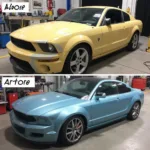Knowing how to spot repair paint on a car is a crucial skill for anyone looking to buy a used vehicle or simply maintain their own. A repainted area can indicate previous damage, potentially affecting the car’s value and structural integrity. This article will guide you through the telltale signs of a respray, equipping you with the knowledge to make informed decisions.
Identifying repainted sections isn’t always straightforward. While some repairs are obvious, others require a keen eye and a bit of detective work. This guide will cover everything from subtle inconsistencies in the paint finish to more noticeable signs like overspray. Let’s delve into the techniques that will help you become a repair paint detective. You can also learn more about how to spot in a paint repair on car on our website.
Visual Inspection: The First Line of Defense
The first step in spotting repair paint is a thorough visual inspection. Walk around the car under different lighting conditions, preferably natural daylight. Look for inconsistencies in the paint’s color, texture, and reflectivity.
-
Color Variations: A slight difference in color between panels is a strong indicator of a respray. The new paint may not perfectly match the original factory paint, especially if the car has been exposed to the elements for a while.
-
Texture Differences: Run your hand lightly over the car’s surface. Repaired areas might feel slightly rougher or smoother than the surrounding original paint. This could be due to differences in paint thickness or sanding imperfections.
-
Orange Peel: This term refers to a slightly textured finish resembling the skin of an orange. While some degree of orange peel is normal, excessive or inconsistent orange peel across panels can suggest a respray.
 Orange Peel Effect on Car Paint Repair
Orange Peel Effect on Car Paint Repair
- Overspray: Check the edges of panels, trim, and window seals for signs of overspray. This is a telltale sign of a rushed or unprofessional repair job. Overspray appears as a fine mist of paint on surrounding areas that shouldn’t have been painted.
Using a Magnet: Testing Paint Thickness
A magnet can be a useful tool for detecting variations in paint thickness, which often occur in repaired areas. A thicker paint layer indicates body filler underneath, suggesting previous damage.
- Magnet Test: Use a small, relatively weak magnet. Run it across the car’s surface. If the magnet’s pull feels weaker in certain areas, it suggests a thicker paint layer and potential body filler underneath.
You can find out more about dark spot paint repair car on our dedicated page.
Checking Panel Gaps and Alignment
Inspect the gaps between panels for unevenness or inconsistencies. Poor panel alignment can be a sign of previous damage that has been repaired. While minor variations can occur in factory assembly, significant discrepancies often indicate repair work. Also, check for signs of rust or bubbling paint, which can suggest underlying issues related to previous repairs or damage. For more information, check out our article on spot repair paint car.
Professional Inspection: When in Doubt
If you’re still unsure after your own inspection, consider seeking a professional opinion. A qualified mechanic or auto body specialist can thoroughly assess the vehicle and identify any signs of repair paint or previous damage. They have the expertise and tools to detect even the most subtle repairs.
You can also learn more about how to repair oxidized car paint spots. And if you are dealing with rust, we also have an article about repair rust spots car paint.
Conclusion
Knowing how to spot repair paint on a car is invaluable for making informed decisions about purchasing or maintaining a vehicle. By using the techniques outlined in this guide – from visual inspections to magnet tests – you can identify signs of previous damage and assess the car’s true condition. While a repainted area doesn’t necessarily indicate a major problem, it’s essential to be aware of any repairs to make informed decisions. Remember, a thorough inspection is crucial for protecting your investment and ensuring your safety on the road.
FAQs
-
What is the easiest way to spot repair paint? Look for color mismatches between panels, especially under natural light.
-
Can a magnet really detect repair paint? Yes, a weaker magnetic pull suggests a thicker paint layer, often indicating body filler and a repair.
-
Is all repair paint bad? Not necessarily. Minor repairs are common, but significant repairs might indicate structural damage.
-
Should I avoid buying a car with repair paint? Not always, but thoroughly investigate the extent of the repair and its potential impact.
-
What should I do if I suspect repair paint? Consult a professional mechanic or auto body specialist for a thorough inspection.
-
Can I repair small paint chips myself? Yes, touch-up paint kits are available, but larger repairs are best left to professionals.
-
How can I protect my car’s paint from future damage? Regular washing and waxing, along with covered parking, can help protect your car’s paint.
For further assistance, please contact us via WhatsApp: +1(641)206-8880, or Email: [email protected]. We have a 24/7 customer support team ready to help.

